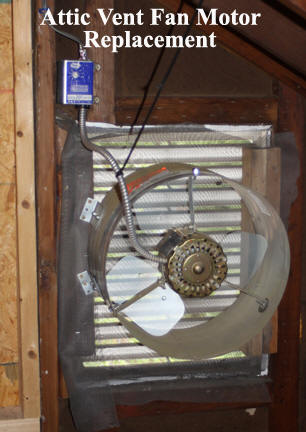
"How to - Replace Attic Vent Fan Motor"
By Ron Stultz
22 July 2012
Summary: easy enough do-it-yourself (DIY) if you have a few tools, your attic is floored or you can balance yourself on ceiling joists and can stand the heat.
Background:
Most attics use at least one, electrically power vent fan, to help pull in cooler outside air through soffits and expel attic heat.
Some attic vent fans are of the gable or on the side of the house type, while others are mounted in the roof itself.

Above is a gable mounted vent fan.
The blue box is the adjustable thermostat.
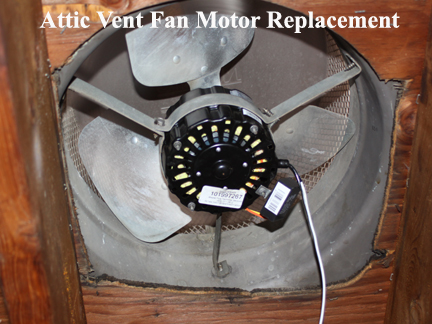
Above is my roof mounted vent fan.
Although not in picture, the cable coming off motor goes to a "blue" box thermostat.
In my large house, I have 2 gable fans and one roof mounted fan.
Attic vent fans are normally attached to a thermostat such that only when the attic temperature gets above a set temperature does the attic vent fan power on.
Even on a relative cool day, say 70 degrees Fahrenheit (F) it will be 90+ degrees F in an attic.
Heat moves from hot to cold, so attic attic is going to radiate into your living space if not controlled via vent fan(s).
Because of high heat, attic vent fan motors do not last forever.
10 years on an attic vent fan motor is a long time.
The most common failure mode of an attic vent fan is that it the motor simply does not run or turn.
Tools needed:
- Voltmeter
- Set of Allen wrenches
- Wrenches or ratchet and sockets: 10 or 11 or 12 millimeter (mm)
Safe working area:
Most home attics are not floored, making moving around difficult and dangerous.
Most home attics do not have any sort of electrical lighting, making it difficult to see well.
Some home attics do not have much height, making movement difficult and dangerous.
SO, survey your attic and if you are uncomfortable with what you would have to do to get to your attic vent fan, hire a professional.
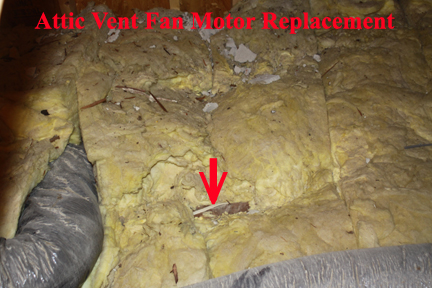
My attic is 90% floored and well lit.
Even so, I have to step on a ceiling joist to get to the 2 gable mounted vent fans.
There is an old "joke" about a leg coming down through the ceiling. Well, I have done with when I was adding insulation to the attic before I floored it. Not laughing.
Is attic vent fan motor really bad:
Never replace anything before confirming the part being replaced is actually bad.
Attic vent fan not working? Could be fan motor OR thermostat OR power not getting to thermostat.
Is circuit feeding attic vent fan circuit breaker tripped?
Probably do not know which circuit breaker powers your attic vent fan(s) so check your breaker box to see if any breakers have tripped.
Move to your attic vent fan and open the thermostat. On most thermostats the cover simply snaps over a shell but depends on your specific thermostat.
\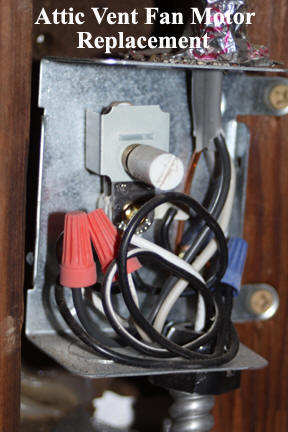
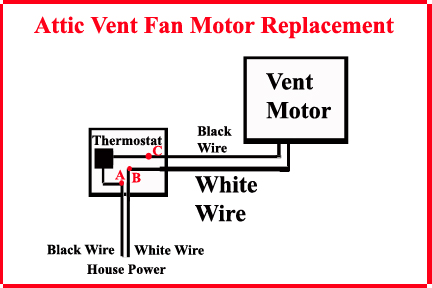
Carefully remove the wire caps from the large black and white wires (feed from house power).
Using a voltmeter, measure voltage across points "A" and "B" or line voltage. If not 120volts alternating current (VAC) either the circuit breaker is tripped or there is a problem with the wiring from the house to the thermostat. (Believe it or not, squirrels and other have been known to chew through electrical wires).
Now measure the voltage across points "B" and "C". Power comes in on the large gauge black and white wire. The power white wire is tied directly to the attic vent motor. The black power line goes to the thermostat and the output of the thermostat (a smaller gauge black wire) is then routed to the attic vent fan motor.
If you have no voltage between the white wire "B" and thermostat black wire "C", use a small flat blade screw driver to turn the thermostat down to its lowest setting or making it turn on the attic vent motor as the lowest possible temperature setting.
Again measure voltage across "B" and "C".
If you still do not read a voltage, the temperature in the attic may be too low to make the thermostat close, so shut down the circuit breaker connected to the attic vent fan. Using a voltmeter, confirm there is no power across points "A" and "B".
When you know there is no power present at the thermostat, remove the power black wire from the black wire that goes to the thermostat and connect it directly to the black wire going the attic vent fan motor. What you are doing is connecting house power directly to the attic vent fan motor.
Turn on the circuit breaker controlling the attic vent fan.
If the attic vent fan motor is now turning, the thermostat is bad and must be replaced. Attic vent fan thermostats are available at all large box home hardware stores (Depot, Lowes, etc).
If the attic vent fan motor is still not turning and you are sure house power is connected directly to the attic vent fan motor, then the attic vent fan is bad.
Remove bad attic vent fan motor:
Although you might be tempted to buy a replacement attic vent fan motor before removing the defective one, do not do so.
Yes, there is some "standardization" in the diameter, and motor shaft length, of vent fan motors, but best to take out defective and measure it before buying new.
How you remove an attic vent fan motor depends on whether fan is a gable type or roof mounted type.
First cut power to the attic vent fan via the circuit breaker and using a volt meter confirm there is no power on the large black and white wires.
On most attic vent fans, there is a metal shield over the black and white wire from the thermostat to the motor.
The power metal shield is attached to the thermostat housing by a push out or other method. If a simple push in, you use a flat blade
screw driver to push out the metal shield plastic molding.
Remove motor from gable type attic vent fan:
Once the attic vent fan motor wire metal shield is loose from the thermostat, use a 10 or 11 millimeter (mm) to remove the screws that hold the vent fan motor to the metal shroud of the attic vent fan.
Remove the screw at the top of the vent fan last so you can hold the entire fan, fan blade and support brackets as you loosen and remove the last screw.
Lift out the entire assembly.
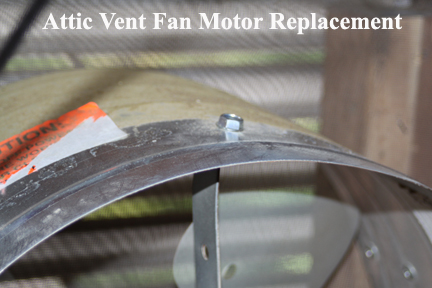
.jpg)
Once you have the entire motor, fan blade and support brackets out of the vent fan shroud, take it to a cooler location.
Pay attention to how fan mounted to motor shaft: where on shaft and how blades pitched. Measure and take notes.
Now using an Allen wrench, find the Allen nut holding the fan blade to the flat side of the motor shaft and remove the fan.
Now use a 10 or 11mm wrench to remove the screws holding the motor to the support brackets.
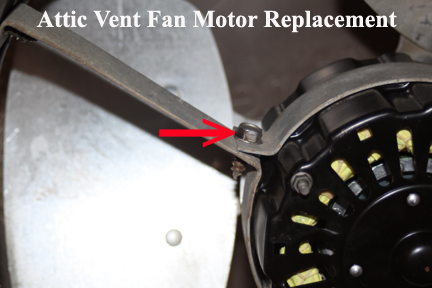
Remove motor from roof mounted attic vent fan:
Getting a motor out of a roof mounted attic vent fan is more difficult than a gable type because you can not get to the screws holding the support struts to the vent shroud.
Once the attic vent fan motor wire metal shield is loose from the thermostat, using a 10 or 11mm wrench, remove the screws holding the support structure around the motor body.
Remove 2 screws and then gently bend the support struts up or down to make room for the motor and fan to be pulled down and out.


Once you have the motor and fan blade out of the shroud, take it to a cooler location.
Before removing the fan from the motor shaft: note position of fan on shaft and how fan blades pitched. Do not want to install fan on new motor with fan to close or too far away from motor or fan reversed so it blowing air into attic.
Now using an Allen wrench, find the Allen nut holding the fan blade to the flat side of the motor shaft and remove the fan.
DIY attic fan motor replacement:
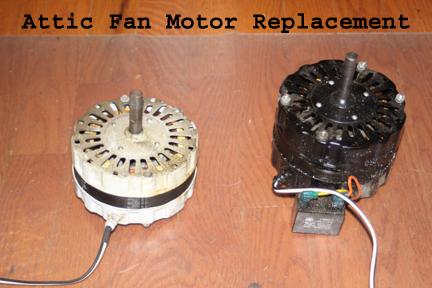
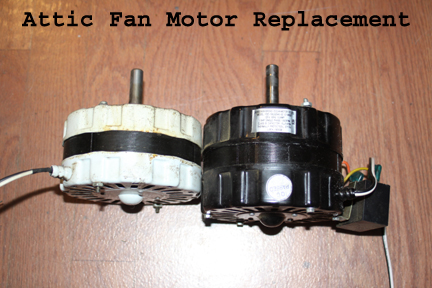
The images above show 2 different attic vent fan motors.
The black motor has a starter capacitor attached while the while motor does not.
Although it is possible the black motor is not working because the starter capacitor is defective, starter capacitors can be harder to find than entire motors.
Although, as you can see, the motors do not have the same height, they do have the same diameter of approximately 5 and 1/4 inches and both motors are held in place by support straps wrapped around the diameter of the motor.
Also the motor shaft length and diameter are also the same.
Thus there is some standardization of attic vent fan motors but before you simply buy a motor of the same or similar diameter, read the plate on the old motor as to defined revolutions per minute or RPM.
Source of replacement attic vent fan motors: local big box home retailer (Home Depot, Lowes), local electric motor repair companies and some plumbing and heater suppliers.
Once you have a replacement motor, put the fan blades on the new shaft and align the set screw with the flat side of the motor shaft and tighten the set screw with the Allen wrench.
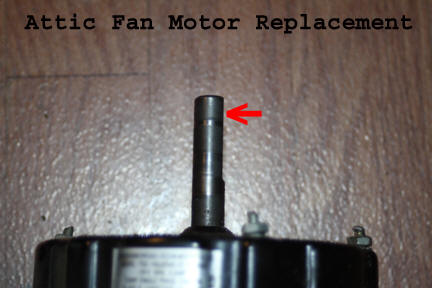
Once you have fan mounted on motor shaft, if motor was gable mounted, remount support bracket around motor.
Take new motor with fan to location.
Reattach motor with fan to either gable or roof mount.
When mounting, make sure motor is in position to allow motor wires to reach thermostat.
If the motor had a metal shield on the wires to the thermostat, thread wires of new motor through shield and then attach shield to thermostat box
With circuit breaker that powers attic vent fan "off", connect white wire from fan motor to larger gauge white wire and "cap" off.
Black wire from motor is connected to black wire coming out of thermostat. Cap off.
Finally, black house power wire is connected to other thermostat black wire. Cap ff.
Now check wiring. White goes to white and house power goes into thermostat and motor black wire is connected to other thermostat black wire.
If all correct, power circuit via circuit breaker.
If attic vent fan does not come on, try moving the thermostat temperature setting to its lowest setting. If fan motor still does not come on, possible it is too cool in attic for thermostat to power motor.
If when the attic is hot, the new motor is still not turning, you need to check wiring in the thermostat.